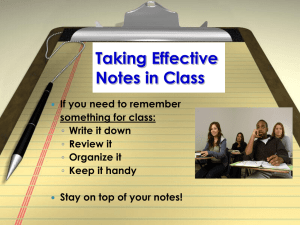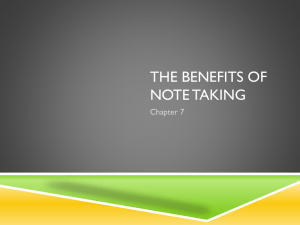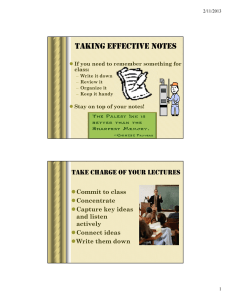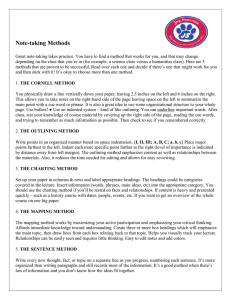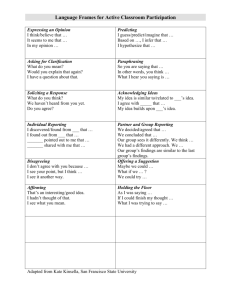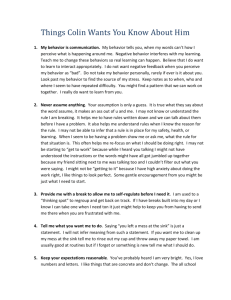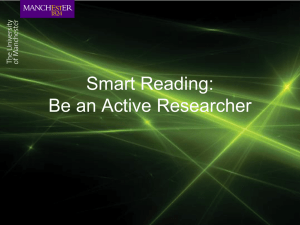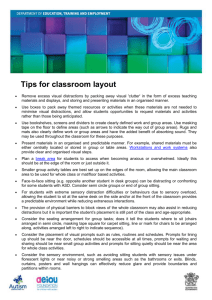STUDY SKILLS
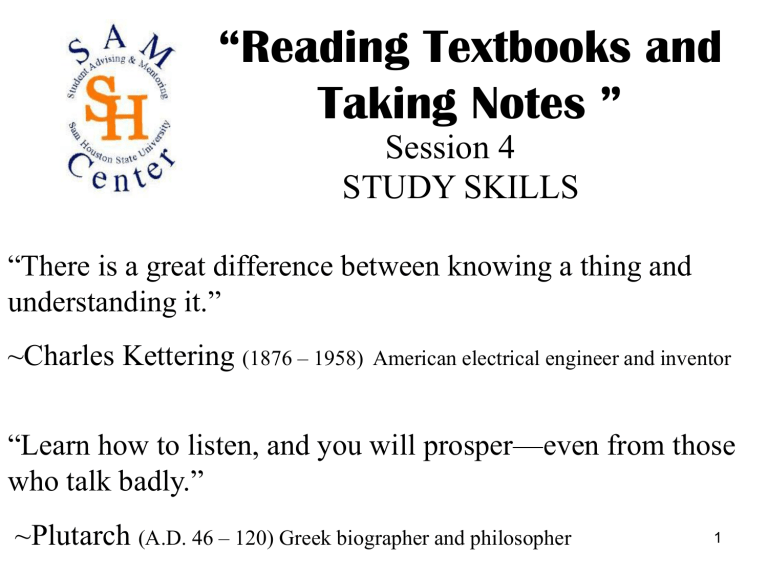
“Reading Textbooks and
Taking Notes ”
Session 4
STUDY SKILLS
“There is a great difference between knowing a thing and understanding it.”
~Charles Kettering
(1876 – 1958) American electrical engineer and inventor
“Learn how to listen, and you will prosper—even from those who talk badly.”
~Plutarch
(A.D. 46 – 120) Greek biographer and philosopher 1
A Positive Attitude Affects
Performance
READING YOUR TEXT • Set a goal.
• Make a “to-do list” when something enters your mind while reading.
• Break the assignment into smaller parts if you feel overwhelmed.
• Help yourself stay focused by utilizing short periods of time.
• Read your most difficult texts first.
• Read actively.
– Ask yourself: What is this saying? Is this important?
• Read a chapter 3 times .
– before the lecture
– after the lecture
– before the exam
Place:
Comfortable chair
Desk or table
No distractions
Equipment:
Highlighter
Ruler
Notepad
Watch or clock
Note cards
Post-its
Dictionary
• Read all online materials in addition to the assigned textbook chapters.
• Break the reading down into small ten-page sections, and reward yourself.
2
Reading a Textbook
Choose a section —preferably no longer than 25 to 30 pages —that you can handle in one sitting (perhaps one chapter or section of a chapter).
Step 1.
Read the title, the introduction, the words in bold print, and the conclusion (5 min).
Step 2.
Now go back and read the whole chapter.
Step 3. Ask yourself two questions: What is this saying? (translate into your own words) Is it important? (if yes, write it on a note card)
3
Learning Strengths Relate to Reading
Textbooks and Taking Notes
My learning strength is:
A. Auditory
– You learn through hearing. Use taped lectures to help you fill in the gaps in your notes. Listen, take notes, and review notes frequently. In the lecture, sit where you can hear well. After you read something, recite it out loud.
C. Tactile
– Trace words as you are saying them. Facts that must be learned should be written several times, so keep a supply of scratch paper for this purpose. Taking and keeping lecture notes will be very important. Make study sheets.
B. Visual
– Look at all study materials. Use charts, maps, videos, notes, and flash cards. Practice visualizing or picturing works/concepts in your head. Write out everything for frequent and quick visual review.
Visit links provided by your professors.
Some may include audio, video, or graphics to supplement the text.
4
The Lecture
Paying Attention in the
Classroom
• Anticipate the main ideas.
• Resist distractions.
• Sit in the “T” zone.
• Remember that you don’t have to sit perfectly still.
Taking Notes
• Be prepared.
– Read text ahead of time.
– Keep your notes organized.
• Write down anything written on the boards.
• Use abbreviations.
• Listen for lecture cues.
– Voice inflection
– Repetition
• Summarize the ideas in your own words.
• Ask questions for clarity.
• Take advantage of recorded lectures by taking notes on the material, just as you would in any other lecture.
5
Taking Notes
Method 1
Organization
Binders or spirals? Using pockets?
Date handouts and notes.
Outline Format
Method — Write in points in an organized pattern based on space indention. Indent more specific points to the right. Levels of importance will be indicated by distance away from the major point.
Advantages — It is a well-organized system if done right. Outlining records content as well as relationships. It also reduces editing and is easy to review by turning main points into questions.
Disadvantages — It requires more thought in class for accurate organization. This system may not show relationships by sequence when needed. This system cannot be used if the lecture is too fast.
When to Use — The outline format can be used if the lecture is organized in outline form.
This format can be most effective when your note-taking skills are super sharp and you can handle the outlining regardless of the note-taking situation.
Example
6
Taking Notes
Method 2
Point form/Sentence Method
Method
—
Write every new thought, fact, or topic on a separate line, numbering as you progress.
Advantages — It is slightly more organized than the paragraph, and it gets more or all of the information.
Disadvantages — You can't determine major/minor points from the numbered sequence. It is difficult to edit without rewriting by clustering points that are related. It is difficult to review unless editing cleans up relationships.
When to Use — Use when the lecture is somewhat organized but heavy with content that comes quickly.
Example
7
